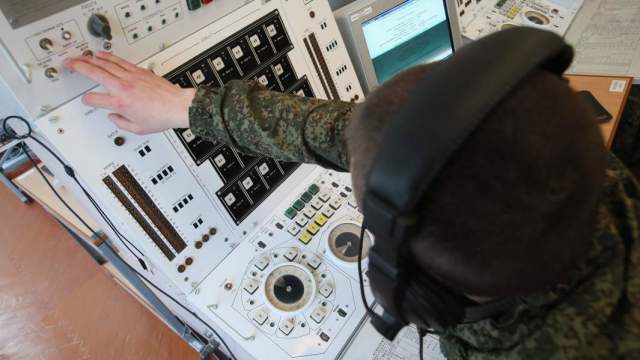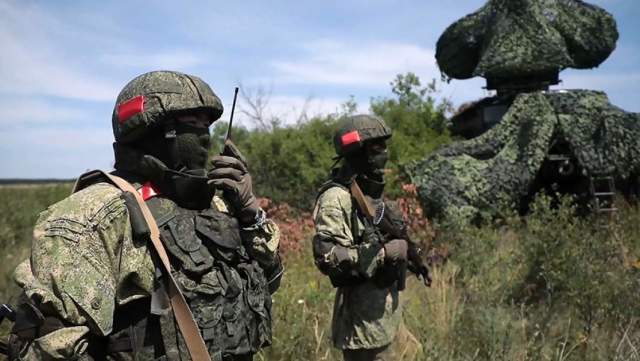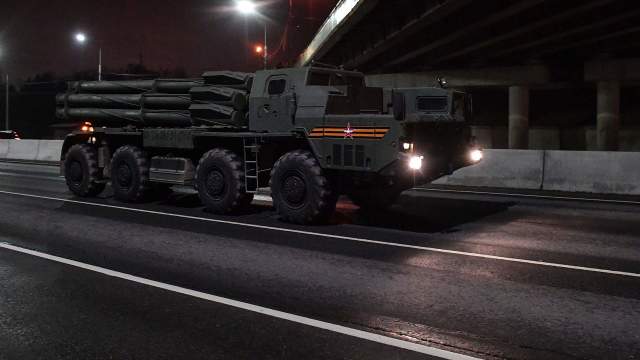Drones are used for electronic warfare and jamming enemy communicationsRussian gunners will start firing drones.
For multiple launch rocket systems (MLRS) Tornado-S is developing missiles with UAVs inside. The devices can be launched at a distance of tens of kilometers, after which disposable drones will temporarily silence communications and radars behind enemy lines. This makes it possible to radically increase the capabilities of electronic warfare of Russian troops. According to experts, promising ammunition will make the Tornado-S an effective means of countering enemy artillery and air defense.
Find and Silence
Experimental work is currently underway to create electronic warfare (EW) drones for the Tornado-S MLRS, sources told Izvestia in the military department. Specialized drones will be placed in rockets that can launch them into the enemy's deep rear. After entering a given area, the drone can jam enemy radio signals, interfere with the operation of radar stations. Such a system can play an important role both in the offensive of Russian troops and in defense.
Drones launched from MLRS will be "disposable": after delivery to a given area, they will barrage for a certain time. Their return to the base is not expected. The use of relatively cheap devices will allow you not to risk airplanes and helicopters with electronic warfare equipment.
The head of the Electronic Warfare Forces of the Russian Armed Forces, Lieutenant General Yuri Lastochkin, has already spoken about plans to create reconnaissance and strike electronic warfare systems based on multiple launch rocket systems and unmanned aerial vehicles.
Electronic warfare systems are needed primarily to counteract counter-battery warfare stations, military expert Alexey Leonkov told Izvestia.
— If such a station is detected, then it is necessary to prevent it from working, — he explained. — And at the same time give out coordinates for the multiple launch rocket system so that it can accurately destroy the object with missiles. In fact, we can say that "Tornado-S" may become a counter-battery system in the future. The main thing is that there is a suitable drone.

Photo: IZVESTIA/Alexander Kazakov
Image source: iz.ru
Electronic warfare equipment usually consists of a complex of electronic intelligence and what then presses on the frequency of this or that device.
— If the system is made correctly enough, the drone will not even have to fly over the front line. Counter—battery fighting stations are usually located in a band up to 50 km," Alexey Leonkov noted.— If the electronic warfare means will work at such a range, then the device will not need to fly "behind the ribbon". He, for example, will be able to detect short-range anti-aircraft systems, transmit coordinates, and a rocket will arrive there.
A few years ago, it was reported that the NGO "Splav" was developing specialized missiles with drones for the Smerch MLRS, the predecessor of the Tornado-S. These devices are equipped with a video camera and are designed for reconnaissance. The range of the Smercha rockets exceeds 70 km. In the autumn of last year, Alexander Smirnov, CEO of NPO Splav, said that preparations were underway to conduct preliminary tests of an experimental batch of rockets with drones with the participation of the customer.
Main caliber
The Tornado-S MLRS, for which ammunition with electronic warfare drones is being developed, is considered the most powerful and long-range jet systems in the world. In the future, they should replace the "Tornadoes" in artillery brigades. There are 12 launchers on each combat vehicle, from which it is possible to fire both a volley and single missiles. The arsenal of the system includes adjustable and unguided projectiles. The exact characteristics of the system are not disclosed, but it was reported that the range of the missiles exceeds 100 km.
Each Tornado-S vehicle receives its exact coordinates via the GLONASS system and is equipped with an automated guidance and fire control system. This allows you to determine the coordinates of the installation and calculate all the necessary parameters for firing targets. The control system receives data on weather conditions and the operation of enemy air defenses. Having received the coordinates of the target from the command post, the MLRS independently performs calculations and deploys launchers. The calculation remains only to give the command to open fire.

Photo: TASS/Press Service of the Ministry of Defense of the Russian Federation
Image source: iz.ru
On-board control systems allow vehicles to be positioned at a distance from each other, which makes them less vulnerable to enemy fire. In addition, they are quickly transferred to the marching position, which allows you to quickly leave the firing position after firing.
Chief of Rocket Forces and Artillery (RViA) Lieutenant General Mikhail Matveevsky told the Russian Armed Forces in an interview with Izvestia that, compared with its predecessor, Tornado-S for the first time in domestic practice, it was possible to defeat small-sized and point targets with guided missiles, including increased power. "At the same time, the firing range has significantly increased. In addition, the introduction of modern automated guidance control systems allows crews to prepare for launch without leaving the crew from the cockpit of a combat vehicle," the general stressed.
The Tornado-S arsenal already includes, in particular, high-precision 9M544 and 9M549 missiles with anti-tank and anti-personnel combat elements. Their range reaches 120 km. In addition, the ammunition is characterized by higher accuracy, due to the fact that they combine satellite and precision inertial navigation systems.
Last year, new correctable ammunition for the Tornado-S was tested. After launching the rocket, they perform a maneuver and enter individual flight paths. This allows you to simultaneously hit several different targets at once, for example, knock out armored vehicles with high-precision missiles, and destroy fortifications and infantry with high-explosive ammunition.
Roman Kretsul

